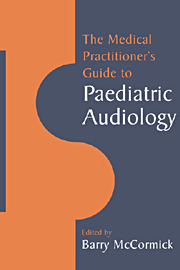Book contents
- Frontmatter
- Contents
- List of contributors
- Preface
- Acknowledgement
- 1 Introduction to hearing problems in childhood
- 2 Causes of deafness
- 3 Behavioural tests
- 4 Pure tone audiometry
- 5 Objective hearing tests
- 6 Middle-ear measurements
- 7 The management of otitis media with effusion
- 8 Management of unilateral hearing loss
- 9 Management of sensorineural hearing loss
- 10 Cochlear implants
- Index
6 - Middle-ear measurements
Published online by Cambridge University Press: 01 October 2009
- Frontmatter
- Contents
- List of contributors
- Preface
- Acknowledgement
- 1 Introduction to hearing problems in childhood
- 2 Causes of deafness
- 3 Behavioural tests
- 4 Pure tone audiometry
- 5 Objective hearing tests
- 6 Middle-ear measurements
- 7 The management of otitis media with effusion
- 8 Management of unilateral hearing loss
- 9 Management of sensorineural hearing loss
- 10 Cochlear implants
- Index
Summary
The need for middle-ear measurements
Tympanometry and middle-ear measurements provide important information about the pathological state of the middle ear. The amount of information to be gained from otoscopy alone is dependent on the skill and experience of the clinician and is variable. Audiological tests are also limited in the information they provide about the middle ear. Behavioural audiological tests give information about air-conduction thresholds only. Full audiometry provides only inferential information about the state of the middle ear when air- and bone-conduction thresholds are compared. Even in cases where an air–bone gap is apparent, audiometry alone gives no information about the reasons for this. Audiometric measurements are subjective and rely on the cooperation of the patient. Tympanometry and middle-ear measurements provide a quick method for obtaining objective information about the middle ear and should be included routinely within the audiological test battery.
Underlying principles of middle-ear impedance
Sound, in the form of longitudinal sound waves, may be propagated through solids, liquids and gases. When the sound waves meet a change in medium, the efficiency of propagation is affected. This change in medium causes some sound waves to be transmitted further, or absorbed and some to be reflected back depending on the different characteristic impedances of the different media. Air has a low, and water has a high characteristic impedance.
- Type
- Chapter
- Information
- The Medical Practitioner's Guide to Paediatric Audiology , pp. 65 - 74Publisher: Cambridge University PressPrint publication year: 1995



